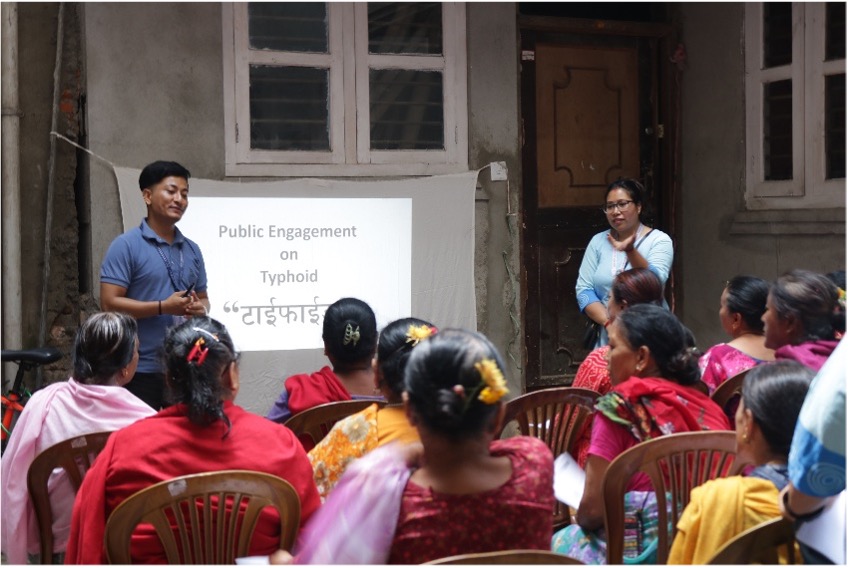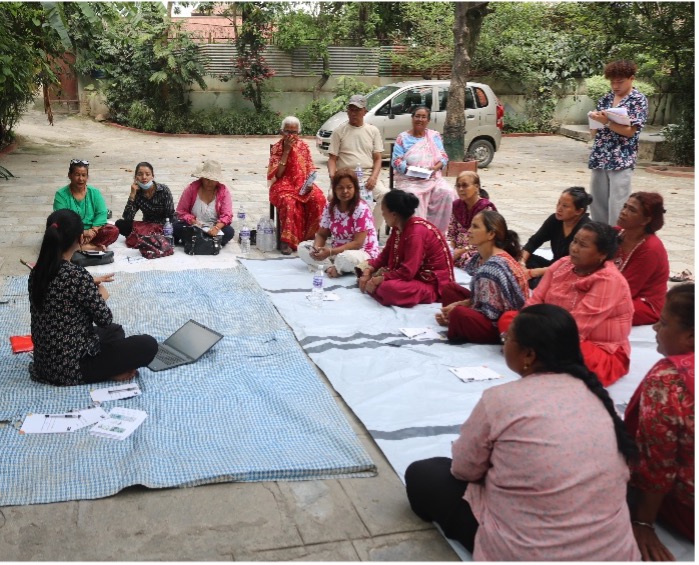Typhoid fever continues to pose a significant public health challenge across many low- and middle-income countries, including Nepal. Caused by the Salmonella typhi bacterium, the disease is primarily transmitted through contaminated food and water. It disproportionately affects children and young adults, particularly in densely populated areas where sanitation and access to clean drinking water remain inadequate. In Nepal, one of the major hurdles in controlling typhoid is the common practice of self-medication with antibiotics, often without professional consultation. This not only delays appropriate treatment but also contributes to antimicrobial resistance (AMR), undermining the efficacy of essential medicines.
In response, the Oxford University Clinical Research Unit (OUCRU) Nepal, in collaboration with Teku Hospital, Civil Hospital, and Bir Hospital in Kathmandu, is conducting a clinical trial to assess the effectiveness of a seven-day course of azithromycin and cefixime compared to azithromycin and placebo. The study focuses on individuals between the ages of 2 and 65 who exhibit fever for more than two days. Alongside this research effort, OUCRU Nepal has initiated extensive public engagement (PE) activities aimed at increasing awareness about typhoid, encouraging responsible health behaviors, and facilitating informed participation in the clinical trial. The PE component plays a vital role in ensuring ethical, community-based research that responds to the realities and concerns of local populations.
Understanding the Burden of Typhoid in Nepal
Typhoid remains endemic in Nepal, despite being a preventable disease. Poor water quality, insufficient sanitation infrastructure, and hygiene-related challenges all contribute to its continued prevalence. Globally, about 75% of typhoid-related deaths occur in Asia, with children under 15 being the most affected. In Nepal, these conditions are further compounded by widespread misinformation, lack of awareness, and the unregulated use of antibiotics. As a result, many individuals delay seeking medical attention or receive inappropriate treatment, increasing the risk of complications such as intestinal perforation, septicemia, and even death.
Community-Centered Public Engagement

As a parallel effort to the clinical trial, OUCRU Nepal has conducted 45 public engagement sessions across various communities in Kathmandu Valley, with an average of 25 participants per session. These sessions are held in accessible venues such as community halls, school grounds, local civil service organizations (CSOs) offices, and even in the yards of residents' homes. The settings are chosen to ensure maximum accessibility and comfort for participants.
The PE sessions primarily target community members living near the hospitals involved in the trial. However, special outreach has also been directed toward vulnerable groups, such as residents of informal settlements, communities affected by seasonal flooding, and neighborhoods with large populations of daily wage laborers. These groups often face additional barriers to healthcare and are more susceptible to typhoid due to poor living conditions.

Each session is conducted in the Nepali language and tailored to the specific needs and knowledge levels of the participants. The content focuses on educating the community about typhoid, its symptoms, transmission, and how it differs from other febrile illnesses like dengue or malaria. Attendees learn about the risks associated with untreated typhoid, including severe health complications and the possibility of long-term illness or death. The sessions also stress the importance of early diagnosis and explain that blood culture is the most accurate method of confirming typhoid, whereas the more commonly used Widal test is less reliable.
In addition to disease education, the sessions focus on improving understanding of antibiotic resistance. Many community members are unaware of the dangers of using antibiotics without a prescription or stopping treatment prematurely. Facilitators explain that such practices reduce the effectiveness of antibiotics and make it harder to treat common infections. This message is particularly important in Nepal, where pharmacies often dispense antibiotics without requiring a doctor's prescription, encouraging widespread self-medication.
Preventive measures are also discussed, including the importance of clean water, proper sanitation, hand-washing, and vaccination. These practical messages are designed to help participants make immediate improvements in their daily habits to protect themselves and their families from typhoid and other waterborne diseases.
During the public engagement sessions, the facilitation team uses interactive methods such as visual aids, storytelling, and group discussions to ensure comprehension and encourage participation. These sessions are designed not just to deliver information, but to foster dialogue and trust. Community members actively engage by asking questions, many of which reflect common concerns and knowledge gaps. A frequent area of inquiry relates to antimicrobial resistance (AMR), where participants ask whether typhoid will become untreatable due to overuse of antibiotics, and how they can protect their families from resistant infections. Others are interested in the direct benefits of participating in the clinical trial, often asking whether all treatments and tests are really free, and what kind of care they will receive during and after enrollment. Parents, in particular, express concerns about the impact of typhoid on their children's health, whether children are eligible for the trial, and whether participation could help prevent recurrent infections. Some attendees are also curious about the trial process itself—how participants are selected, whether there are any risks involved, and how their information will be used. These questions indicate that while there is a general openness to learning and participating, clear communication and reassurance are critical to building confidence in both the research and the health system.
Explaining the Clinical Trial
As part of the engagement process, detailed information about the clinical trial is shared with communities. Facilitators explain the purpose of the trial, its significance, and how it contributes to better understanding and treatment of typhoid. Community members learn about who is eligible to participate—individuals aged 2 to 65 years with a fever lasting more than two days—and the steps involved in enrollment.
Participants in the study receive a diagnostic blood test. If typhoid is detected or strongly suspected based on the clinician’s evaluation, the individual is enrolled in the trial. Those who participate are provided with a range of free medical services, including consultations, laboratory tests (blood, urine, stool where needed), and medications. They also receive structured follow-up care via phone and in-person visits at Day 7, two weeks, and one month after treatment initiation. Travel expenses for these follow-up visits are reimbursed, ensuring that financial constraints do not prevent continued participation.
This approach provides not only valuable research data but also much-needed health services to the community, many of whom might otherwise face barriers to accessing quality care.
Addressing Barriers to Participation
A major barrier to recruiting participants for the clinical trial is the common tendency of people to begin antibiotic treatment as soon as they develop a fever, often before seeking professional medical advice. This widespread behavior affects the accuracy of blood culture results and disqualifies individuals from participation in the trial. OUCRU Nepal’s public engagement sessions are designed to confront this issue directly. Facilitators encourage attendees to seek medical care promptly and to avoid self-medicating, emphasizing that correct diagnosis and timely treatment are crucial not only for personal health but also for ensuring effective research outcomes.
These discussions often resonate with community members who have experienced or witnessed the negative consequences of self-treatment. Through relatable stories, simple visuals, and respectful dialogue, the sessions help reshape attitudes and behaviors regarding antibiotic use and healthcare-seeking.
Why Engagement Matters
Many people in Nepal have limited understanding of what clinical research entails and may perceive it as something foreign or risky. One of the key objectives of the public engagement initiative is to build trust by demystifying the research process and highlighting its potential benefits for individuals and communities.
Through these sessions, OUCRU Nepal makes it clear that clinical trials are conducted with ethical oversight and prioritize participant well-being. The engagement efforts emphasize that participation is entirely voluntary, that individuals can withdraw at any point without penalty, and that all services are provided free of charge. Moreover, participants are treated with dignity and respect, and all medical services are delivered in a timely and professional manner.
By explaining the reciprocal nature of clinical research—how it not only gathers scientific data but also offers real healthcare benefits, the PE initiative fosters a more informed, empowered, and cooperative public. This understanding builds the foundation for sustained community engagement and stronger healthcare relationships.
Conclusion: A Model for Ethical, Impactful Research
OUCRU Nepal’s integrated approach—combining rigorous clinical research with responsive, community-based engagement—is an exemplary model for improving public health in resource-limited settings. The dual focus on scientific inquiry and social responsibility ensures that the research is not only ethically sound but also culturally relevant and accessible.
By conducting clinical trials alongside robust public education efforts, the initiative helps communities become more informed about their health, more critical of unsafe practices like self-medication, and more open to participating in research. As typhoid continues to affect vulnerable populations in Nepal, this model of combining science with social engagement offers a compelling path forward toward health equity and sustainable impact.
